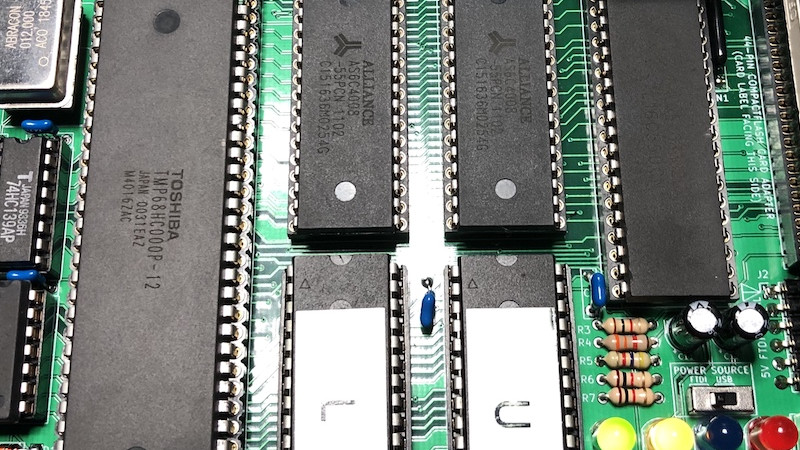For those of us who remember the Motorola 68000 microprocessor, it’s likely that a sizeable quantity of those memories will come in the form of a cream or grey box with a Commodore, Atari, or Apple logo on it These machines were the affordable creative workstations of their day, and under the hood were a tour de force of custom silicon and clever hardware design. We might, therefore, be excused for an association between 68000 based computers and complexity, but in reality, they are as straightforward to interface as the rest of the crop of late-1970s silicon. We can see it in [Matt Sarnoff]’s 68k-nano, about as simple a 68000-based single-board computer as it’s possible to get.
But for all its simplicity, this board is no slouch. It packs a megabyte of RAM, 64k of ROM, a 16550 UART, and an IDE interface for a CompactFlash card. There is also provision for a real-time clock module, through an interesting bit-banged SPI interface from the 16550’s control lines. There appears also to be a 50-pin expansion header.
Software-wise there is a ROM monitor that provides test and housekeeping functions, and which loads an executable from the card plugged into the IDE interface if there is one. This feature makes the board especially interesting, as it opens up the possibility of running a μClinux or similar kernel for a more fully-featured operating system.
The 68k doesn’t receive the attention here that some of its 8-bit contemporaries do, but it still appears from time to time. We’ve certainly featured at least one other 68000-based SBC in the past.
Thanks [Anton] for the tip.
















I used to think a lot of wiring up a 680×0 board. I would probably use a 68020 or 68030 because they can be configured to use an 8 bit bus interface, in particular for ROM. The 680×0 family was always a great favorite with me, but at this point, playing with little ARM SBC seems more fun and productive. I have a bunch of giant old sun3 boards I can play with if I want to go the nostalgia route, so maybe I never will wire up anything.
Cool. Is there some kind of video implemented?
In progress :) https://twitter.com/txsector/status/1284297630390992896?s=20
𝕴 𝖒𝖎𝖘𝖘 𝕷𝖃𝖁𝕴𝕴𝕴𝖐 𝖆𝖘𝖘𝖊𝖒𝖇𝖑𝖊𝖗!
𝕿𝖍𝖆𝖙 𝖜𝖆𝖘 𝖆 𝖓𝖎𝖈𝖊 𝖊𝖗𝖆!
𝕲𝖎𝖌𝖆-𝕾𝖎𝖌𝖍.
I built Jeff Trantor’s board, but have not had the opportunity to troubleshoot it.
This board looks much simpler and yet more capable at the same time.
I would like to keep an eye on this project to see what reviews brings.
I am mainly interested in seeing CP/M running. Possibly a video output. And uClinux also sounds quite interesting. Although I’m not sure what Linux software would actually run?
I would nearly submit the Gerber to jlcpcb.com right now.
check out the builderpages section on retrobrewcomputers.org for user “Plasmo”, he’s got an assortment of 68×00 boards which run CP/M. Keep in mind 68K CP/M is pretty old and lacking in features compared to what’s available on Z80.
“it’s likely that a sizeable quantity of those memories will come in the form of a cream or grey box with a Commodore, Atari, or Apple logo on it”
I would also think majority of people who knew of 68000 but not in a computer are those who has fond memory of Sega Genesis (or Mega Drive outside North America)
> in the form of a cream or grey box with a Commodore, Atari, or Apple logo on it
Nah. The first 68000 I put through its paces was an Apollo. Great piece of kit! But it is put to shame by my Raspberry Pi…
I started building my own 68k-based SBC in 1988. That made sense then, but didn’t finish it. Now, I’d rather use an ARM Cortex: gets you off the ground so much easier. And STM makes excellent dev boards for next to nothing….
Well of course if you want to be productive professionally ARM is the way to go.
The 68k is for fun like the z80 and 6809. All three are still understandable by mere mortals instead the ARM which isn understood by a handful of turbo nerds who can digest a 3000 page databook in a couple of hours
Same here, but 2 years earlier. The German magazine C’t had published the KatCE, a single eurocard sized 68K with native assembler and Pascal compiler. After that I designed and build my own VME version on a double eurocard protoboard. Months of fun.
How come there is no love the Roscoe 68K? This is the most promising looking 68XXX SBC to date. It could be the next RC2014.
https://rosco-m68k.com
Could be overlooked but yeah the Rosco looks promising
Good old grounded DTACK, eh? As long as all the other parts are fast enough for the bus it works great.
I’m still surprised it only took two logic gate chips, even with sloppy address decoding.
Vector base in ROM (0h). That’s way too restrictive, unfortunately.
For what? It’s a hobbyist SBC, it’s not meant to do everything.